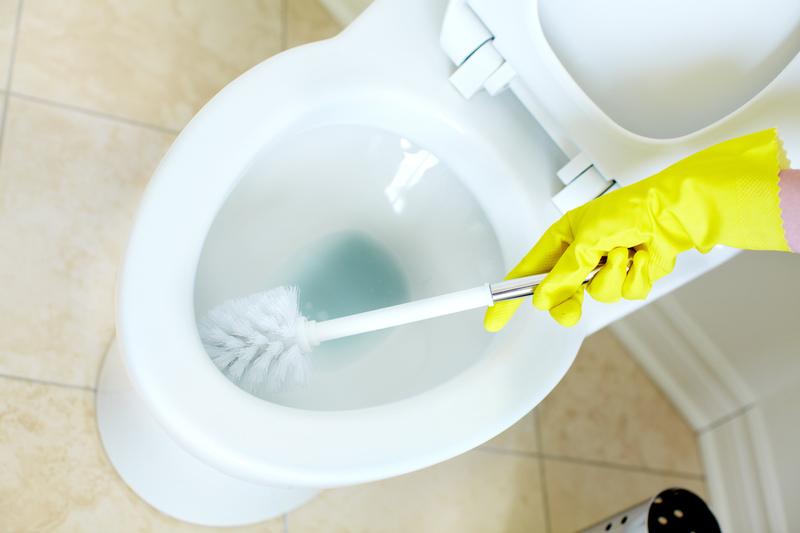Easy and Effective Methods to Clean Mouldy Window Sills
Posted on 10/09/2025
Easy and Effective Methods to Clean Mouldy Window Sills
Struggling with mouldy window sills? You're not alone! Mould on window sills is a common nuisance that not only looks unsightly but can also pose health risks. In this comprehensive guide, we'll explore the best ways to clean mouldy window sills, prevent regrowth, and maintain a healthy home environment. Read on for easy, effective, and eco-friendly solutions!
Why Do Mouldy Window Sills Happen?
Mould forms on window sills primarily due to excess moisture, insufficient ventilation, and sometimes condensation issues. Understanding what causes mould growth helps in both treating and preventing it. Here's why your window sills might be attracting mould:
- Condensation: Cool window surfaces mixed with warm indoor air create moisture - a perfect breeding ground for mould.
- Poor ventilation: Stagnant air makes it easier for dampness to linger.
- High humidity: Areas like kitchens and bathrooms are especially susceptible.
- Leaky windows: Structural issues or defective seals can let rainwater seep in.
Whatever the cause, removing mould from window sills should be a priority to avoid damage and allergies.

Health Risks of Mouldy Window Sills
Mould is more than an aesthetic issue. Prolonged exposure can lead to a variety of health concerns, especially in sensitive individuals. Some risks include:
- Allergic reactions (runny nose, sneezing, itchy eyes)
- Asthma attacks or respiratory problems
- Worsened symptoms for those with weakened immune systems
That's why it's vital to clean black mould from window sills as soon as you spot it!
Supplies You'll Need to Clean Mould from Window Sills
Before you begin, gather these essential items to make your job both safe and effective:
- Protective gloves and mask (to avoid breathing in spores)
- Cleaning cloths or sponges
- Bucket of warm water
- Stiff brush or old toothbrush
- Spray bottle
- Cleaning solution (see eco-friendly and chemical options below)
- Paper towels or microfibre towel
- Vinegar, baking soda, hydrogen peroxide, or bleach (choose based on your method)
Quick Tips Before You Start Cleaning Mouldy Window Sills
- Open windows for ventilation during cleaning and while drying.
- Avoid mixing chemicals (never combine bleach and vinegar or ammonia).
- Be gentle with wooden or painted sills to prevent damage.
- Test cleaning solutions on a small, hidden area first.
Easy Home Remedies to Clean Mouldy Window Sills
1. Cleaning Mould from Window Sills Using White Vinegar
Distilled white vinegar is a natural antifungal and one of the most effective ways to remove mould from window sills. Follow these steps:
- Fill a spray bottle with undiluted white vinegar.
- Spray generous amounts onto the mouldy window sill.
- Let it sit for at least an hour to dissolve the mould spores and roots.
- Wipe with a damp cloth, scrubbing tougher spots with a toothbrush.
- Repeat if necessary, then dry thoroughly.
Tip: Vinegar's odour fades as it dries but opens windows to help dissipate the smell.
2. Baking Soda Solution for Cleaning Mold Off Window Sills
Baking soda is safe, mild, and acts as a gentle abrasive for scrubbing off black mould from window sills.
- Mix one teaspoon of baking soda with two cups of water in a spray bottle.
- Spray onto the window sill and scrub gently with a soft brush.
- Wipe with a damp cloth.
- Spray again and leave to air-dry for lasting mould protection.
3. Hydrogen Peroxide: Deep Cleaning Mouldy Window Sills
Hydrogen peroxide not only kills mould but is also effective against bacteria and viruses.
- Pour 3% hydrogen peroxide into a spray bottle.
- Spray generously over the mouldy area.
- Let it fizz for 10-15 minutes, breaking down spores.
- Wipe with a brush, then a clean damp cloth.
Hydrogen peroxide is safe for most surfaces, but always do a patch test!
4. Bleach Solution: Powerful but With Caution
For tough infestations, bleach can be used, but note it may damage wooden or painted surfaces. It's best for non-porous surfaces like vinyl or metal sills.
- Mix one cup of bleach with one gallon of water.
- Apply to the mouldy surface using a cloth or sponge (always wear gloves and open windows!).
- Let it sit for 10 minutes, then scrub and wipe clean.
- Rinse with clean water and dry thoroughly.
Never mix bleach with vinegar or ammonia!
How to Clean Mould from Wood Window Sills
Wooden window sills require extra care because wood absorbs moisture, making it tricky to clean mould without causing further damage. Here's how:
- Use a vacuum cleaner (with a HEPA filter) to remove mould spores gently.
- Spritz a light mist of diluted vinegar or hydrogen peroxide on the mould. Avoid saturating the wood.
- Wipe in small circular motions. Use a soft brush for stubborn spots.
- Immediately dry the area with paper towels or a fan.
- If stains persist, sand gently when dry and repaint or reseal.
Never oversaturate wooden window sills - excess moisture could worsen the mould problem!
Preventing Mouldy Window Sills: Tips for Long-Term Results
Once you've cleaned your mouldy window sills, it's crucial to prevent recurrence. Follow these strategies to keep your window sills mould-free:
- Reduce humidity: Use dehumidifiers in rooms prone to dampness.
- Promote airflow: Open windows regularly or use fans to maintain circulation.
- Repair leaks: Fix any water ingress from damaged seals or panes.
- Wipe condensation daily: Especially in winter, clearing water prevents moisture buildup.
- Treat with anti-mould spray: Available at most hardware stores or make your own with vinegar and tea tree oil.
- Regularly inspect sills: Check for early signs of mould and address immediately.
- Keep sills clean and dust-free: Brush or wipe weekly to remove dirt and spores.
Eco-Friendly Solutions for Cleaning Black Mould from Window Sills
Eco-friendly cleaning options protect both your home and the environment. Here's a roundup of green solutions to remove window sill mould:
- Tea Tree Oil: Mix a teaspoon of tea tree oil with two cups of water and spray. Its natural antifungal properties eradicate mould and leave a fresh scent.
- Grapefruit Seed Extract: Add 20 drops to two cups of water. Spray and leave to dry for continued protection.
- Vinegar and Baking Soda Paste: Create a paste, spread onto stubborn mould patches, let sit, then scrub off.
How to Clean Mould Off Window Sills Quickly (for Busy Households)
If you're short on time but need to tackle toxic black mould on window sills, here's your go-to method:
- Wipe away loose mould with a dry microfibre cloth (dispose of cloth afterward).
- Spray white vinegar and leave for 2-3 minutes.
- Wipe with a damp sponge.
- Dry thoroughly with paper towels or a clean towel.
Speedy tip: Doing this weekly can prevent larger buildups!
When to Call a Professional for Mouldy Window Sill Cleaning
While most household mould can be addressed with DIY methods, sometimes professional intervention is needed. Watch out for:
- Mould covering large areas (more than 1m2)
- Persistent musty odours even after cleaning
- Recurrent or spreading mould despite effort
- Visible water damage or rot on sills and frames
- Suspected toxic black mould (Stachybotrys chartarum), which requires special handling
If these symptoms are present, contact a professional mould remediation service for safe removal.
Maintaining Refreshingly Clean Window Sills All Year Round
Keeping your window sills mould-free is achievable with regular care and vigilance. Here's a quick maintenance checklist:
- Wipe window sills weekly with a damp cloth and mild cleaner.
- Inspect seals, sills, and frames after rain or damp weather.
- Address condensation immediately every morning in winter.
- Repaint or seal wood and masonry to create a moisture barrier.
Even a few minutes each month goes a long way in preventing mould on window sills!

Frequently Asked Questions About Cleaning Mouldy Window Sills
Is it safe to clean black mould from window sills myself?
Generally, small patches are safe to clean with home remedies and precautions (gloves, masks, ventilation). For larger infestations or toxic mould, seek professional advice.
Can vinegar remove all types of mould on window sills?
Vinegar is effective against most household moulds but may not fully eliminate deep-set mould stains. For persistent mould, try hydrogen peroxide or consult professionals.
How do I prevent mould from coming back on the windowsills?
Control indoor humidity, promote ventilation, repair leaks, and keep surfaces dry and clean. Regular cleaning with vinegar or anti-mould agents helps prevent regrowth.
Are mouldy window sills dangerous?
Yes, especially for children, elderly people, or those with respiratory ailments. Address mould promptly and thoroughly to ensure safe indoor air quality.
Conclusion: Say Goodbye to Mouldy Window Sills!
Cleaning mouldy window sills doesn't have to be difficult. With these easy and effective cleaning methods, you can remove unsightly mould, keep your home healthy, and prevent future outbreaks. From natural solutions like vinegar and baking soda to targeted products and professional help, you're now equipped to tackle mould on window sills head-on.
Start today, and enjoy fresh, spotless window sills all year round!
Looking for more cleaning tips? Bookmark this page for seasonal advice and share with friends who need a hand with cleaning mouldy window sills. A clean home starts with you!




